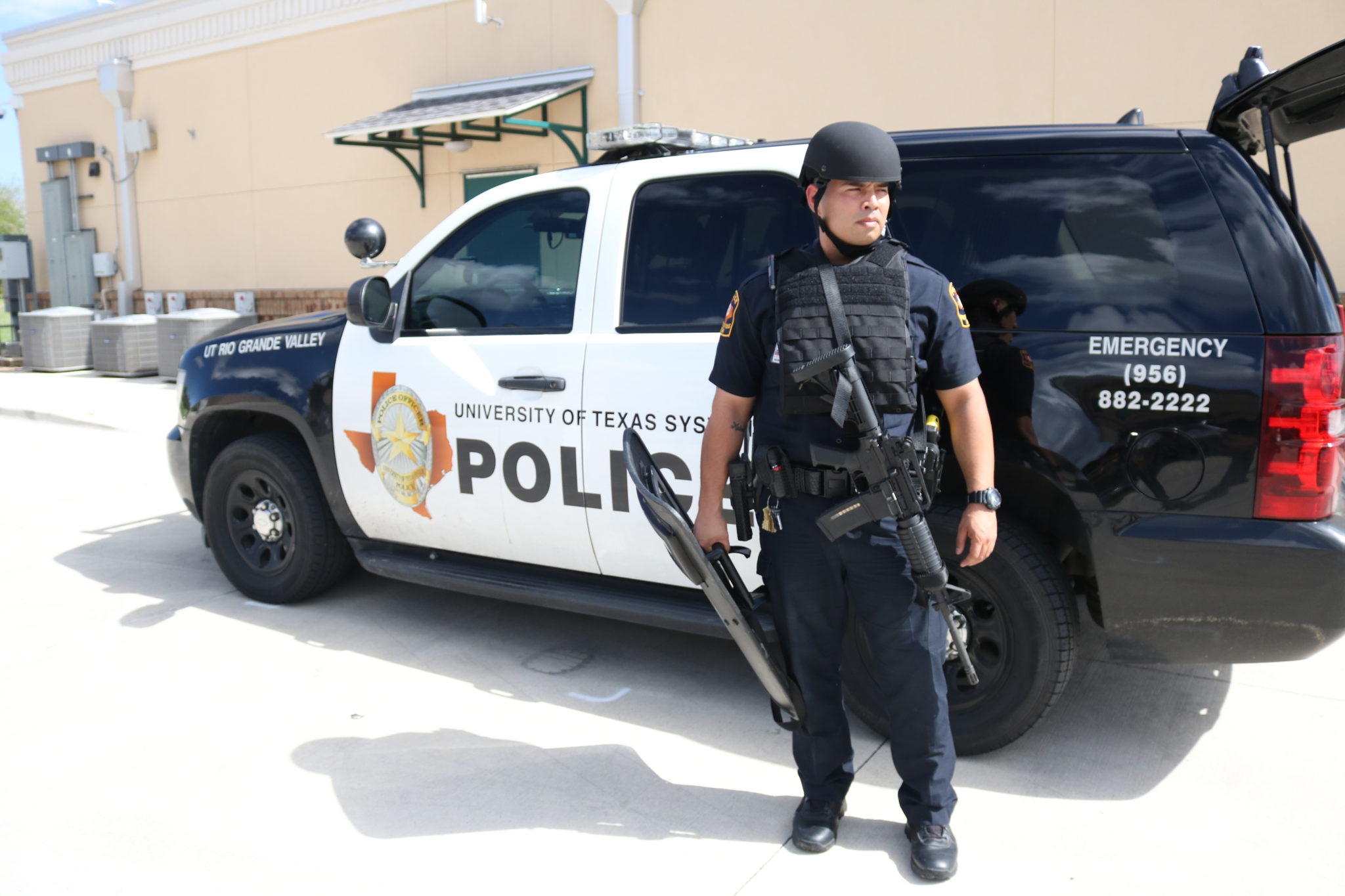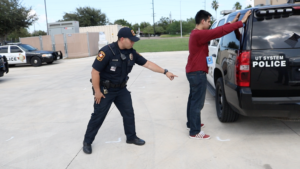
After the mass killing in Las Vegas and murder of a Texas Tech officer in the last two weeks, University Police say they have protocols in place for an active-shooter situation at UTRGV.
University Police Assistant Chief James Loya told The Rider the department offers students, faculty and staff a Civilian Response to Active Shooter Event training (CRASE).
“[CRASE] teaches concepts of run, hide or fight,” Loya said. “Ultimately, when you’re faced with an active-shooter situation, if you can run and leave the situation, you need to go ahead and do so. … Once you’re out, you need to make sure law enforcement are contacted.”
If individuals cannot run from an active-shooter situation, the next thing to do is hide, the assistant police chief said.
“You can barricade yourself in a room, turn off the lights, make sure the door is locked,” he said. “If you can’t lock the door, you should try to put a barrier between you and door and the threat, which is outside.”
If individuals cannot run or hide and the active shooter is visible to them, Loya said the only thing left to do would be to fight and protect themselves and the ones around them.
“It’s not really one clear-cut answer for everything,” he said. “If you could, take advantage of those trainings when we do offer them. … We’ve already trained over 400 faculty, staff and students in that concept.”
Training courses are offered on the Edinburg and Brownsville campuses. A minimum of 10 people must sign up for a course to be offered.
To register for training, visit utrgv.edu/police/services/training. For more information, call University Police Department Training Officer Antonio Zarzoza at 665-2988 or email him at antonio.zarzoza@utrgv.edu.

On Oct. 1, Stephen Paddock shot dead 58 people and wounded more than 500 during a country music concert on the Las Vegas Strip before killing himself. It was the worst mass shooting in modern U.S. history.
Less than a week later, Hollis Daniels, a 19-year-old Texas Tech University freshman, allegedly shot and killed police Officer Floyd East Jr. after his arrest on campus Oct. 9.
Texas Tech Police made a student welfare check and found evidence of drugs and drug paraphernalia in Daniels’ dorm room after receiving complaints that the suspect was acting erratically and may have had a weapon, according to the Lubbock Police Department report. Daniels was taken to the police station for standard debriefing when the incident occurred, according to a Texas Tech statement.
At the time of the debriefing, Daniels was not wearing handcuffs, according to the police report.
Loya told The Rider suspects are normally handcuffed when arrested.
“I’m not quite sure exactly how the situation played out in Texas Tech,” he said. “When a person is in custody, under arrest, they normally are handcuffed. I just don’t know where they were in the process.”
The assistant chief said sometimes handcuffs may need to be moved from the back to the front.
When booking a suspect, University Police do not hold anyone in the station. Suspects are transferred to either the Brownsville or Edinburg police departments.
“Ultimately, when somebody is placed under arrest, they are patted down, they are searched and at that point, they’re searching for any weapons or contraband that you don’t want taken into a building or jail,” Loya said.
Even though campus police does not hold prisoners at its UTRGV stations, it does have interview rooms on both campuses if a suspect needs to be questioned. Suspects remain handcuffed in the interview rooms, Loya said.
Lt. Samuel Hernandez and Officer Michael Garcia demonstrated the procedures all UTRGV law enforcement officers must follow.
When starting their shift, University Police officers must gather all their equipment first, which includes an AR-15, an automated external defibrillator, first-aid kit and breaching tools.
In thet event of an active shooter, UTRGV officers also carry tactical gear, which includes a police shield, bulletproof vest and helmet. Every unit contains a fire extinguisher as well.
Hernandez and Garcia showed The Rider the bulletproof vest officers must wear at all times.
UTRGV patrol officers always carry a police-duty belt, which weighs about 15 pounds.
The belt carries a pepper spray can, a Taser and two extra cartridges, a high-frequency radio that allows officers to communicate across the Rio Grande Valley, a flashlight, a set of handcuffs, latex gloves for medical emergencies, an ASP baton, a .40-caliber pistol and two extra magazines with 15 rounds each.

Every University Police officer must undergo and continue training to use all equipment.
Under the Texas campus carry law, which was signed into law by Texas Gov. Greg Abbott in 2015 and took effect August 2016, Daniels was not old enough to possess a handgun.
The campus carry law allows license holders to carry a concealed handgun while on the campus of an institution of higher education in the state. The law states concealed carry license holders must be at least 21 years old and have no felony convictions, among other conditions.
Daniels was living on campus when the incident occurred.
Published reports say an affidavit released last Tuesday states Daniels confessed to the killing of East. Daniels did not use a police department gun in the shooting. However, no weapon was found during the search of Daniels’ dorm room.
At UTRGV, the possession of a firearm is prohibited, except for license holders who may carry or store a concealed handgun in personal vehicles.
All individuals, including license holders, are prohibited from openly carrying a handgun or other firearm on any UTRGV campus.
Sergio Martinez, director of Housing and Residence Life, told The Rider concealed handguns are prohibited in areas of UTRGV residential facilities that do not provide sufficient space solely under a resident’s control to permit the safe storage of a handgun. Areas include Unity, Heritage and Troxell halls in Edinburg and double-occupancy rooms designed for shared living at the Casa Bella student housing complex in Brownsville.
However, some Casa Bella rooms and the Village Apartments allow the storage of concealed handguns if residents provide their own handgun safe meeting or exceeding UTRGV specifications.
“[Students] provide their safe and we will bolt it down inside the closet to secure the safe,” Martinez said. “The safe has to be made of metal, must be of a sturdy grade, must be lockable with a key and must be able to be secured.”
UTRGV Housing and Residence Life also conducts housing safety checks, which are conducted twice a semester.
The checks are geared toward making sure there are no fire safety issues, but during the inspections, Housing and Residence Life staff may find any policy or law violations, which are reported to campus police.
Martinez said students help the most when it comes to pointing out violations.
“Our goal is to create community and as a good community that we help create, the students assist us and we’ll tell students, ‘You’re our eyes and ears. We need your help in being vigilant,’” he said.
The recent shootings across the nation have begun a conversation among U.S. senators regarding gun laws.
Some senators have voiced their opinion via Twitter. Sen. Bernie Sanders (I-Vt.) tweeted the following on Oct. 2:
There have been more mass shootings than days this year. It is long, long overdue for Congress to take action on gun safety.
— Bernie Sanders (@BernieSanders) October 2, 2017
President Donald Trump offered his condolences via Twitter.
My warmest condolences and sympathies to the victims and families of the terrible Las Vegas shooting. God bless you!
— Donald J. Trump (@realDonaldTrump) October 2, 2017
After the Texas Tech incident, government officials also used Twitter to voice their messages.
Texas Gov. Greg Abbott tweeted:
Statement on the shooting that occurred at @TexasTech this evening. pic.twitter.com/J92GP7UGOp
— Gov. Greg Abbott (@GovAbbott) October 10, 2017
At UTRGV, criminal justice Associate Professor Philip Ethridge told The Rider that individuals, nowadays, are purchasing all kinds of weapons.
Ethridge said gun control laws come down to the state.
“Judicially, states have done very little to control guns,” he said. “At the local and state level, especially in the state level, there are very few controls.”
Ethridge, however, said he feels safe on campus because University Police has done a great job with the CRASE training. The criminal justice associate professor has taken the training himself.
Dawson Phillips, a biology senior at the UTRGV Mathematics and Science Academy, said he also feels safe on campus.
“I feel safe,” Phillips said. “We’re next to the border, so we have, you know, [U.S.] Border Patrol. We have a lot of police here and I think, overall, we have a pretty safe area. The Valley as a whole is pretty safe.”
He said he believes people should become more informed about gun control to be more prepared during an active-shooter situation.
“We just need to improve on more education as to what guns do, how to handle them, how to handle a situation where someone has a gun,” Phillips said. “I think that will be the main way to improve the whole gun situation.”
Loya said University Police will continue to remain vigilant while patrolling and protect the campus community as best as it can. He asks students, faculty and staff to alert the department about any concerns, no matter how small they may seem.
The assistant police chief said he encourages the campus community to undergo the CRASE training.
“If it’s not a training here with us, I know a lot of the community police departments … [conduct] these active-shooter trainings as well,” Loya said. “Get yourself familiar with some type of response. … The training that you go through with CRASE is not necessarily to help you just on campus; it’s going to help you when you’re at the mall, when you’re at the movies or when you’re at a restaurant. A lot of people, you know, they make you more aware of your surroundings. … It’s a sense of awareness that people need to have and, of course, report. If you see something suspicious, report it to the police. … [We] would rather get calls 100 times than not get that one call that could’ve made a difference.”





